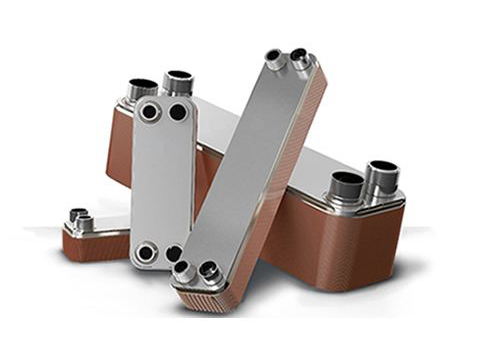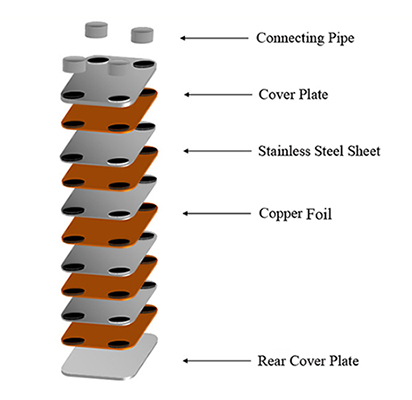Cleaning and Disassembly of Plate Heat Exchanger
Sun, Jan 12 by ATO.com
Due to small circulation cross section of the plate heat exchanger, blocking is easy to occur after scaling, which reduces heat exchange efficiency and directly affects safe operation of the equipment and progress of production work. This article introduces key points and precautions of the plate heat exchanger during disassembly and cleaning, and provides a guarantee for safe and efficient descaling to the plate heat exchanger.
Disassembly for Plate Heat Exchanger
- Before disassembling the plate heat exchanger, measure and record the compacted length of plate bundle. It should be installed at this size when reinstalling.
- If the gasket is stuck in the groove between two plates, carefully separate it with a screwdriver. Screwdriver should first be inserted from the easily peelable part, and then be separated along its periphery. Do not damage the heat exchanger plates and gaskets.
- When replacing the new gasket, first wipe the gasket groove with acetone or other ketone organic solvents. Then apply a synthetic resin adhesive to the grooves with a brush.
- Check the heat exchanger plate for holes. Generally, a 5x magnifying glass is used, and sometimes it can be inspected piece by piece using light or kerosene penetration method.

- If sundries is found in the medium inlet/outlet short pipes and channels, it indicates that the filter is invalid and should be cleaned in time.
- There are three methods for cleaning plates: backflushing (cleaning without disassembly), manual cleaning (cleaning with disassembly), and chemical cleaning (cleaning without disassembly).
Manual cleaning. When the fouling thickness of heat exchange plate is very thin and insoluble in water, can disassemble the heat exchanger. Use the water with pressure (0.1-0.2 MPa) or low-pressure steam with water to jet and wash each plate. For sediments that are difficult to wash off with water, use a soft fiber brush or a bristle brush to scrub.
Chemical cleaning. If there are hard deposits (oxides or carbides) on surface of the heat exchange plate (especially in dead corner of the medium flow), it is difficult to solve it by manual cleaning. At this time, use different chemical solvents for cleaning according to material of the heat exchange plate. - When heat exchange plate is scarred, do not use a wire brush or a wire hair brush to clean it, especially stainless steel plates, to prevent accelerate corrosion of plates. If there are stains or rust on plate, it can be removed with decontamination powder.
- The water used to clean the plates must be free of salts and sulfur.
- After cleaning the heat exchange plate with chemical cleaning method, it must be cleaned with water. Then wipe it with a fine gauze cloth and put it in a clean place.
- When dismantling titanium plates, it is strictly forbidden to come into contact with open flames to prevent oxidation.
- Check the sealing gasket for defects such as aging, deterioration, cracks, etc. It is forbidden to scratch on the surface with hard objects.
- It is strictly forbidden to accumulate solid particles, such as sand and iron slag, on the surfaces of sealing gaskets and heat exchange plates (in the trench).
- Inspect the heat exchange plate for local deformation. If deformation degree exceeds the allowable value, it shall be trimmed or replaced.
Assembly for Plate Heat Exchanger
- Before reassembling the components, clean the qualified heat exchange plates, gaskets, heads (head covers), clamping bolts and nuts.
- Before bonding gasket and groove, dissolve the residual glue in groove with acetone or other ketone organic solvents, and then wipe it with a fine gauze cloth.
- Use a bristle brush with the same width as gasket groove, apply synthetic resin adhesive to the plate groove. Then press it into sealing gasket, flatten it with a flat steel plate, and leave it for 48 hours.
- Use organic solvent such as acetone to dissolve the residual gum squeezed out of the groove and remove it.
- When replacing the new gasket, carefully check the positions of four corner holes for gasket. The location must be the same as the old gasket.
- When one plate of plate heat exchanger is damaged and there are no spare parts, can remove this plate and the adjacent plate at the same time, and then tighten the clamping bolt.
- When reassembling plate heat exchanger, the plates should be alternately rotated by 180 ° for stacking, and no wrong assembly is allowed. To determine whether the plate is installed wrong, judge it from the triangle mark on plate center. As long as the reverse (▽) positive (△) of the triangular mark on plate center is staggered overlay, there is no wrong installation.
- Clamping bolts shall be tightened evenly, symmetrically and crosswise.
- To prevent the gasket from sticking with plate, can apply a layer of mixture to the gasket. The proportion of oil, alcohol and talc used in the mixture is 1:1:2 by weight.

Cleaning for Plate Heat Exchanger After Scaling
- Selection of cleaning agent
About the selection of cleaning agents, currently pickling is used, which includes organic acids and inorganic acids. Organic acids include oxalic acid and formic acid. Inorganic acids include hydrochloric acid and nitric acid. According to analysis of heat exchanger structure, technology, material and scale composition, the following conclusions can be drawn.
- Plate heat exchanger has small circulation area and complicated internal structure. If the cleaning solution precipitates, it will not be easily discharged.
- Plate heat exchanger material is nickel-titanium alloy. If using hydrochloric acid as the cleaning solution, it is easy to cause strong corrosion to plates and shorten service life of the heat exchanger.
Through repeated experiments, it was found that using formic acid as the cleaning liquid is better. Adding buffering agent and surfactant to formic acid cleaning solution, the cleaning effect is better, and corrosion to the plate by cleaning solution can be reduced. Chemical experiments on scale samples have shown that formic acid can effectively remove scale. Through the acid soaking test, it was found that formic acid can effectively remove the scale attached to plates, and at the same time, it has little corrosion effect on plates of the heat exchanger.
- Process requirements of cleaning scale for plate heat exchanger
- Pickling temperature. Increasing the pickling temperature is beneficial to improve the descaling effect. It should be noted that if the temperature is too high, it will aggravate corrosion of pickling liquid to heat exchanger plate. Through repeated tests, it was found that it is appropriate to control the pickling temperature at 60℃.
- Pickling solution concentration. According to repeated tests, the pickling solution is formulated at a concentration of 81.0% formic acid, 17.0% water, 1.2% buffer, and 0.8% surfactant, the cleaning effect is better.
- Pickling method and time. Pickling should be performed by a combination of static immersion and dynamic cycling. First soak for 2h, then cycle for 3~4h. During the pickling process, samples should be taken frequently and tested for pickling concentration. When the difference between concentrations of two adjacent assays is less than 0.2%, the pickling reaction can be considered to be over.
- Passivation. After pickling, most of the scale and metal oxides on surface of the plate heat exchanger are dissolved and peeled off, exposing brand-new metal and is easy to corrode. Therefore, after pickling, the heat exchanger plates need to be passivated.
- Specific steps of cleaning scale for plate heat exchanger
- Flush plate heat exchanger. Before pickling, first flush the plate heat exchanger to ensure that there are no impurities such as mud and dirt inside the heat exchanger. This can not only improve the effect of pickling, but also reduce the acid consumption of pickling.
- Pour the cleaning solution into cleaning equipment and then pour it into heat exchanger.
- Pickling. Soak the plate heat exchanger filled with acid solution for 2h. Then continuous dynamic cycling for 3 to 4 h. During this process, alternate cleaning in positive and negative every 0.5h. After pickling, if the pH value of acid solution is greater than 2, the acid solution can be reused. Otherwise, dilute and counteract the acid solution and then discharged it.
- Alkaline washing. Prepare with NaOH, Na, PO, demineralized water at a certain ratio. Then, make alkaline washing to the heat exchanger in a dynamic cycle to achieve acid-base neutralization, so that the heat exchanger plate is no longer corroded.
- Water scrubbing. After alkaline washing is finished, repeatedly wash the plate heat exchanger with clean demineralized water for 0.5 h. Rinse the residue from the heat exchanger thoroughly.
- Record. During the cleaning process, strictly record the time of each step to check cleaning effect. In short, after cleaning, the plate heat exchanger should be subjected to a pressure test. Then it can be used after passing.
- Measures to prevent scaling of plate heat exchanger
- Strictly control water quality during operation of the plate heat exchanger. The water in system and the demineralized water in demineralization tank must be subjected to strict water quality tests before they can be injected into pipe network.
- When commissioning a new system, separate the heat exchanger from system. After a period of circulation, then integrate the heat exchanger into system to avoid impurities in pipe network from entering the plate heat exchanger.
- Dirt separator and filters should be cleaned irregularly throughout the system. In addition, pipe network should be kept clean to prevent blockage of the plate heat exchanger.
In summary, cleaning the plate heat exchanger in strict accordance with the cleaning method is an important guarantee for normal operation of the production.

